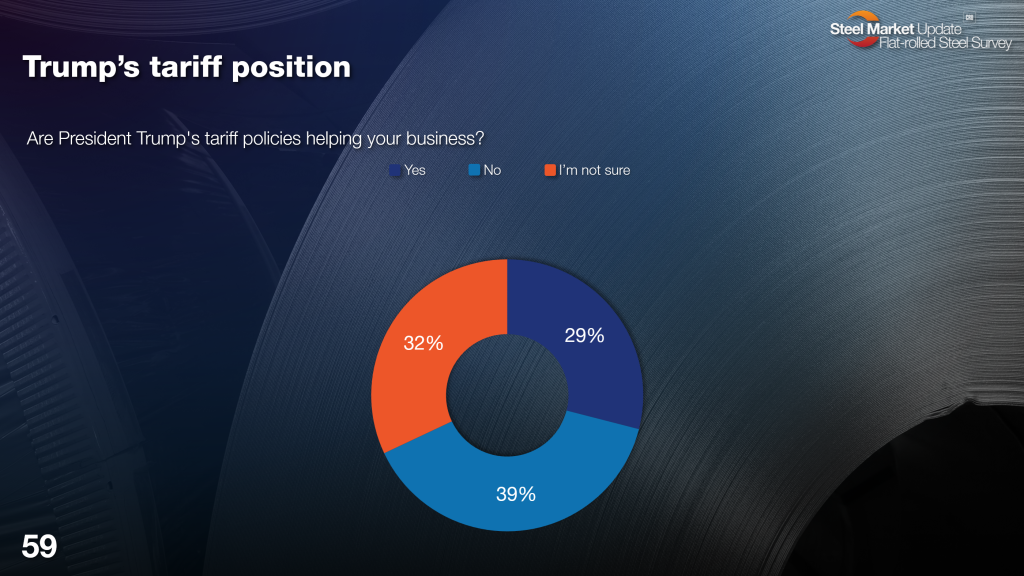Market Data

March 21, 2025
SMU Survey: Perspectives differ on impact of Trump tariffs
Written by Ethan Bernard
There’s no getting around the fact that tariffs are driving much of the present news cycle for steel. And here at SMU, we’ve written about the issue from many angles, trying to provide a fuller picture of what’s happening out there. With our SMU survey, we also have access to a unique insight into the situation: You.
That is, we put out a question in our most recent steel buyers survey and got back a lot of informative commentary.
We asked if President Trump’s tariff policies were helping your business. Why or why not?

The response was mixed and interesting. Perhaps some of what makes it interesting is the fact that it’s so mixed; that no consensus has emerged yet. We’re still firmly in the “fog of tariffs” stage. In the survey, 29% said tariffs were helping, 39% said they weren’t, and 32% were unsure.
Though no clear majority emerged, the “Not helping” crowd is currently in the lead.
Our survey participants fall all along the supply chain, so let’s dig directly into those “Why or why not?” responses to see what they reveal.
Unsure, uncertain?
First, there were some responses that pointed to the jury still being out. Just beyond that, many others said there is a lot of uncertainty. And uncertainty is not known to be something that often helps markets.
“Too early to tell.”
“Too soon to tell.”
“Hasn’t changed much to this point, depends how long they remain in place.”
“Tariff policies are unstable, making it hard to determine what outcomes may be.”
“Uncertainty is causing a pause.”
“We are importers. Too much uncertainty.”
“Inconsistent tariff policy is causing a lot of hesitation and panic. Forecasting is hindered because of the unknown direction.”
Yes. Or yes, but…
As far as helping, there were responses in that vein. However, there were also “Yes, but…” comments as well.
“More domestic demand helps domestic mills.”
“Yes, until they affect production in a material way.”
“Short-term gain on higher-priced domestic steel.”
“The tariffs have raised prices and margins, but there will also be the equal and opposite side of this cycle, which will not be as beneficial to us.”
“I think they are helping in some areas and hurting in others.”
“Helping our US company and not helping in Canada or Mexico.”
No. Or no, but…
Then there were the responses that pointed out some pain points emerging for the respondents. And also “Not now, but maybe later” comments as well.
“Being an OEM, tariffs are creating surcharges for our customers.”
“Lots of supply chain disruptions.”
“As a manufacturing (company), steel prices are increasing too fast and we cannot pass on to market at the same rate.”
“Hitting aluminum with such a large tariff and on lumber kills the residential construction market.”
“Raised our costs artificially.”
“Higher inflationary pressure. Reduced exports. Higher interest rates… Reduced GDP.”
“I think this will cause significant pain for OEMs and create a large spike in inflation, but this will be a smaller version of the Covid run-up in costs.”
“Orders have softened and will continue to soften. The tariff policies make our costs go up straight across the board. At some point, it simply makes products too expensive and people stop buying.”
“They are costing me and my customers a lot of money. And, yes, we the importer pay the tariff—not the supplier. And, yes, we pass it on, and, yes, the final customers will see higher costs.”
“In the short term I feel they are hurting our business with all of the uncertainty and how flat rolled mills raised prices excessively, taking every dime they could get. Once the dust settles and we have clarity on what tariffs will or won’t be our business, we will benefit from them.”
It’s complicated
A Barron’s article on Friday had the headline: “Steel earnings are lousy. Weren’t tariffs supposed to help?”
Later in the article, it’s hedged a bit, pointing out that the jump in steel prices came in late February, the differences between spot and contract buying, and the lag time between orders and deliveries, among other things.
Still, as to whether the tariffs are helping, judging from our survey participants’ responses: It’s complicated. At least there’s some nuance depending on whether you’re a mill, a service center, or further down the supply chain. And even within those categories, there are differing perspectives.
With upcoming decisions on the Canada/Mexico blanket tariff issue, reciprocal tariffs, and the wild cards that could be played any day by this administration… this is definitely very much a developing situation.







